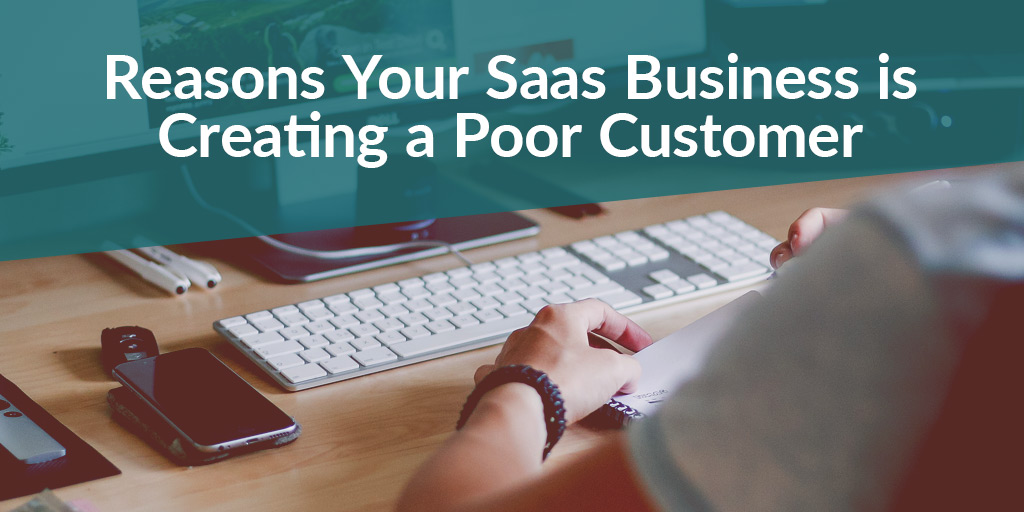10 Reasons Your SaaS Business is Creating a Poor Customer Experience

Having a great SaaS product isn’t enough. You probably have a competitor that provides a similar tool. So how do you differentiate yourself?
Through a strong, painless customer experience.
The customer experience is about how customers interact with your product and your team. It’s about truly understanding how your product impacts your customers, and following strategies that maximize that impact. It’s about creating satisfied customers and looking beyond your quarterly benchmarks.
It’s the bond that keeps customers coming back.
In 2011, 86% of buyers said they were willing to pay more for a better customer experience, according to the Annual Customer Experience Impact Report. Researchers at Walker report that by 2020, customer experience will be a “key brand differentiator,” more so than price and the product itself.
Every company creates a customer experience. If you haven’t taken deliberate actions to understand and steer yours, you probably have a poor one. Chances are you’re making several of these mistakes.
1. You don’t have a smooth onboarding process

The first interaction a customer has with your SaaS “sets the tone for the relationship.” If the customer is confused, overwhelmed or frustrated, they’ll apply that first impression to every other interaction they have with your company and look for reasons to churn.
But onboarding is about more than just feelings. In most cases, onboarding is described as the first time a customer receives value from the product. If your SaaS is a CRM, first value might be when your customer uses your software to contact their first lead. This is easy value to achieve. If your SaaS is an ecommerce platform, the customer might consider first value to be their first sale. This is much harder.
The goal is to get your customer from sign up to first value as quickly as possible. The shorter this window, the less likely they’ll churn.
2. Your employees aren’t on board
Inevitably, your customers will interact with multiple people within your organization. This is especially true if you sell an enterprise software with long sales cycles and custom integrations.
Everyone in the organization needs to understand the type of customer experience you’re trying to create. They need to know how to perform their jobs in a manner that supports that experience.
For instance, most SaaS businesses strive to create a painless onboarding process. This means reducing the customer’s involvement in your internal workings as much as possible. So if an employee needs a basic piece of information about a customer, their process should be to ask within your organization first before inquiring with the customer. If the customer is bombarded with repeat requests, their experience will suffer.
3. You treat all your customers the same
Even if you serve a small niche, your customers can be broken down into segments according to their problems and needs. One customer may expect a communicative partner while another wants to be as hands-off as possible.
Furthermore, customer needs change based on the customer lifecycle and the growth of their business. If you treat every customer the same, you’ll disappoint most of them in small ways.
4. You think customer experience development is expensive
You may think that dealing with vague concepts like the customer experience divert resources from making sales or improving the product. This couldn’t be further from the truth.
Customers who enjoy the experience with your company will expand their service and renew. In this way, improving the experience directly supports your revenue. As we know, it’s easier to keep a customer than find a new one.
Each time your customer renews is essentially a new sale. So for SaaS businesses, creating a powerful customer experience that keeps churn low is a sales tactic. The program will pay for itself.
5. You aren’t speaking to the right people

It’s important that you communicate the right things to the right people in your customer’s organization, otherwise your efforts will be wasted.
Let’s say your customer’s marketing guru has a problem. You know a solution is available, but it requires a technical procedure. Instead of painstakingly walking the non-technical person down a solution he doesn’t understand, ask to speak to a developer who can handle it. Better yet, bring your developer into the conversation so two technical people can work together. This saves everyone’s time and avoids a lot of frustration.
Here’s another example: You just came across a great article with sales automation tips. Do you send it to everyone at the customer’s company? Maximum value, right? No, not at all. The salesman will enjoy it, but the database administrator will consider it spam.
6. You don’t have enough face-to-face communication time
Email is a beautiful tool because it builds separation into the conversation. I send you a message on my time and you reply on your time. But that disconnection isn’t always productive when the customer wants a problem solved right now.
A big part of Customer Success is building relationships with your customers, and relationships require some face time.
Whenever possible, encourage Skype or Google Hangout calls. Often a dozen emails can be replaced by a short conversation. This will make the customer feel like they’re worthy of your time. This is especially true for B2B products because your customers are probably strapped for time.
7. You have created a post-sale gap
The period immediately following a sale is a critical moment of the customer experience. The customer has made a commitment. Now they are wondering if they have made the right decision. If they are going to feel buyer’s remorse, this is when it’s most likely to happen.
Once you’ve made a sale, make it a point to engage the customer. Give them avenues to find value with the product right away. Put the customer on track to use the product in whatever manner solves their specific problems. This will begin the customer experience on the right foot.
8. You’ve fallen in love with metrics

Don’t get me wrong. Data is extremely important.
In many cases, even the most sophisticated data lacks critical information. It might, for instance, be able to point out a problem, but not explain why the problem is happening.
Never underestimate the value of a check-in with customers or ex-customers. Often their behavior in your analytics doesn’t match with the problem they actually have.
For example, a customer may disappear during their setup process, so you assume something was wrong with their onboarding experience. Upon investigation, however, you learn that your service received a negative endorsement by the customer’s trusted friend. This is something your analytics couldn’t have predicted. If you hadn’t called, you wouldn’t have known.
9. You don’t have a real support system
I don’t expect Customer Success Managers to fall into the role of providing customer support (hopefully you have dedicated people to do basic troubleshooting), but a customer who can’t use the product won’t be a customer much longer.
All SaaS have bugs, whether they’re in the software itself or the process that provides the service. Most customers are remarkably forgiving, provided you take swift, productive steps to solving their problem.
Customer problems don’t exist in a vacuum. If one customer is experiencing a challenge, you have to assume that other customers are dealing with the problem as well, but they aren’t speaking up. Even if you’re comfortable losing a single complainer, your problem is bigger than it appears.
Furthermore, make the support process painless. Aspect Software found that one third of customers would “rather clean a toilet” than speak with customer support. Long waits, clueless support technicians and “did you try restarting?” procedures poison the experience. Make yourself accessible with live chat, Twitter support, and someone who actually reads the general inbox.
10. You aren’t helping the customer achieve their goals
Customers who achieve their goals don’t churn, they renew their service. They’re also likely to increase their consumption, expand their services, and tell others about their success.
Keep in mind that you aren’t the only solution. Your customers can use a competitor, use an open source solution, use a homegrown solution, or outsource the work to other people. If you can’t help the customer achieve their goals, they’ll quickly move on.
Avoid selling to customers with goals you can’t help them achieve. This means aligning your sales and marketing teams with your product’s core functionality.
Prioritizing the customer experience is not without challenges. It requires serious resource allocations and the return on your investment may be difficult to quantify upfront. But the alternative is unhappy customers who don’t value the relationship, which is unacceptable.
